Byzantine Catholic Archeparchy - Pittsburgh, Pennsylvania
First Metropolitian of the Archepharchy of Pittsburgh

Born: June 11, 1915
Ordained: March 30, 1941
Enthroned First Bishop of Passaic: July 31, 1963
Enthroned First Metropolitian Archbishop of the
Byzantine Archepharchy of Pittsburgh: October 23, 1956
Died: March 7, 1995
Stephen John Kocisko was born in Minneapolis, Minnesota on June 11, 1915. He was the son of John Z. Kocisko and Anna Somos.
His father John Z. Kocisko was born in Minneapolis in 1888. Not long after his birth the family returned to Slovakia. His birth/baptism was entered into the Lutheran church records in the village of Hanusovce nad Topl'ou, Slovakia. It was noted in the entry that he had been born in Minneapolis. He was the son of Anna Zelenak a Greek Catholic of Carpatho-Rusyn decent and John Kocisko a Lutheran of Slovak descent. Both John and Anna were born in the village of Bystre, Slovakia. By 1910 John had returned to America. On February 22, 1911 at the age of 22 he enlisted in the Army at Fort Snelling, Minnesota. He served for three years with the Coast Artillery in California as a mechanic. John was discharged on February, 1914 at Ft. Barry, California.
John married the former Anna Somos on July 11, 1914. They were married in Alden, Pennsylvania by a Greek Catholic priest, the Rev. Anthony Lotowyez. Anna Somos was born in Nanticoke, Pennsylvania. She was the daughter of Andrew Somos a Greek Catholic of Carptho-Rusyn background from the village of Lozin, Slovakia and Anna Rost. John and Anna had nine children from 1915 to 1938. John supported his growing family from approximately 1914 to 1940 as an inspector at a flour mill. As of 1920 they were renting a residence on California Street in North East Minneapolis. The family relocated by 1930 to their own home on 22nd Avenue in Minneapolis.
Stephen grew up in Minneapolis and graduated from De La Salle Catholic High School. He went on to Nazareth Preparatory Seminary in St. Paul, Minnesota. Bishop Basil Takach transferred him to Saint Josaphat’s Seminary in Rome where he undertook courses in philosophical and theological studies. He graduated with a Licentiate (Masters) Degree in Sacred theology. He was ordained to the holy priesthood in Rome by Bishop Alexander Evreinoff on March 30, 1941. He returned to the United States and was assigned churches in Detroit Michigan, Lyndora and Michigan, Pennsylvania. He was named to the Exarchate’s Matrimonial Tribunal and also served as a professor at the Byzantine Catholic Seminary of Saints Cyril and Methodius in Pittsburgh. Due to expansion, Bishop Nicholas Elko petitioned His Holiness, Pope Pius XII for an auxiliary bishop. This request was granted and on October 23, 1956 Father Stephen Kocisko was enthroned as a bishop at the Cathedral of Saint Paul of the Roman Catholic Diocese of Pittsburgh. Bishop Kocisko began his tenure at Holy Ghost Parish in Pittsburgh. For the next number of years he performed his duties as auxiliary bishop and also was appointed Rector of the Seminary and also as Vicar General.
On July 6, 1963 the Holy See advanced the status of the Greek Catholic Church in America from Exarchate to Eparchy. His Holiness, Pope Paul VI placed the church into two separate jurisdictions. One was the Byzantine Catholic Eparchy of Passaic and the second which was in Pittsburgh included the rest of the United States. Now, the new Eparchy of Passaic required a Bishop. The Pope approved the installation of Bishop Stephen Kocisko as the first Bishop of the Byzantine Catholic Eparchy of Passaic. On July 6, 1963, Bishop Kocisko was enthroned at the Cathedral of Saint Michael the Archangel in Passaic, New Jersey. Bishop Koscisko had a monumental task to undertake. He had to construct a new Eparchy which included a chancery and outline plans for it’s administration and management. He also was instrumental in beginning the Eparchy newspaper “The Eastern Catholic Life.” In conjunction with all these duties, he also attended the Second Vatican Council in Rome.
On December 22, 1967, Bishop Kocisko was elevated as the replacement of Bishop Elko as head of the Ruthenian Byzantine Catholic Church in America. He was enthroned in Pittsburgh on March 3, 1968 and Father Michael Dudick was enthroned as the new Bishop for the Eparchy of Passaic. On February 23, 1969 Pope Paul II published a decree “Quandoquidem Christus” that elevated the Ruthenian Byzantine Catholic Church in America into a Metropolia. The Eparchy of Pittsburgh was advanced to an Archepharchy and the Eparchy of Passaic became a suffragan to the Metropolia. On February 29, 1969 Pope Paul VI appointed Bishop Stephen Kocisko to the status of Archbishop. Later, on June 11, 1969 Archbishop Stephen Kocisko was enthroned as the first Metropolitan in the history of the Rusyn faithful. The Most Reverend Luigi Raimondi, Apostolic Delegate to the United States presided at the ceremony. Metropolitan Kocisko immediately began work by establishing an Office of Religious Education; a Cantor’s Institute and promoted an Archeprchial Museum to preserve the history and religious holdings of the Archepharchy. He also encouraged many publications, books and pamphlets. The subjects dealt with the Americna church but also with those regarding the history of the Epharchy of Presov, Slovakia and Mukachevo, Ukraine. In 1974 he assisted with the construction of a Byzantine chapel at the National Shrine of the Immaculate Conception in Washington, D.C., and in 1986, Metropolitan Kocisko along with the Bishops of the Ruthenian Metropolitan Province began the cause for canonizations of three bishops (Bishops Theodore Romzha of Mukachevo, Paul Gojdich of Presov and Basil Hopko of Presov) who had been martyred for the faith in Eastern Europe.
During February of 1990, Metropolitan Kocisko travelled with others of the American Byzantine Catholic hierarchs to the Eparchy of Presov and Mukacevo to support them after so many years of persecution. As was church tradition, Metropolitan Kocisko submitted his resignation to Pope John Paul II on June 11, 1990. He was 75 years old and his health was beginning to fail. At the time of his resignation, Metropolitan Kocisko had served as a priest for fifty years and thirty-five years as a Bishop/Metropolitan. On March 7, 1995, Metropolitan Kocisko died and was interred at Calvary Cemetery of Mount Saint Macrina in Uniontown, Pennsylvania.
The Anaphora from the Installation of The Most Reverend Metropolitan Archbishiop Stephen Kocisko on June 11, 1969 in Holy Spirit Byzantine Catholic Church, Pittsburgh, Pennsylvania. The singing is the Carpatho-Rusyn Prostopinije liturgical chant of the Ruthenian Byzantine (Greek) Catholic Church.
His Excellency Metropolitan Thomas Dolinay, D.D.
Second Metropolitan Archbishop
of the Archepharchy of Pittsburgh

Born: July 24, 1923
Ordained: May 16, 1948
Installed First Auxiliary Bishop of Passaic: November 23, 1976
Enthroned First Bishop of Van Nuys: March 9, 1982
Enthroned as Metropolitan: May 16, 1991
Died: April 13, 1993
His Excellency Metropolitian Judson Procyk, D.D.
Third Metropolitan Archbishop
of the Archepharchy of Pittsburgh
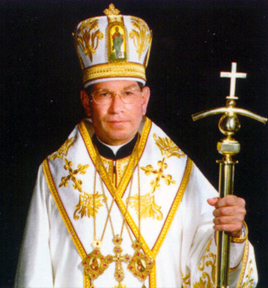
Born: April 9, 1931
Ordained: May 19, 1957
Elevated to Title of Monsignor/Prelate of Honor: March, 1975
Enthroned as Metropolitan: February 7, 1995
Died: April 24, 2001
Metropolitan Judson Michael Procyk was born April 9, 1931 in Uniontown, Pennsylvania. He was the son of Michael Procyk and Mary (Buchko) Procyk. He had two siblings, Ida (1925-2012) and Henry. Michael Porcyk was born and raised in the city of Lubaczuw in the former Galicia region, present day Southern Poland. He was employed as a truck driver for Original Wonder Bakers located in Uniontown, Pennsylvania. He raised his family in South Uniontown, Pennsylvania.
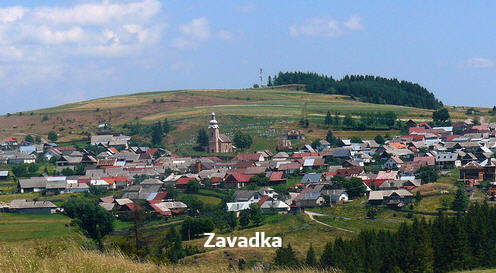 Metropolitan Judson’s mother Mary Buchko departed for the U.S. on February 8, 1902 sailing on the SS Neckar sailing from the port of Bremen, Germany. She was traveling with her mother Mary (Possiak) Buchko and younger sister Helen. Their last residence was listed as the village of Zavadka, Slovakia, formerly known as Zavadka, Szepes, Hungary. They arrived at the Port of Halifax, Nova Scotia, Canada on March 3, 1902. Their final destination was Stauffer, Pennsylvania to join Mary’s father.
Metropolitan Judson’s mother Mary Buchko departed for the U.S. on February 8, 1902 sailing on the SS Neckar sailing from the port of Bremen, Germany. She was traveling with her mother Mary (Possiak) Buchko and younger sister Helen. Their last residence was listed as the village of Zavadka, Slovakia, formerly known as Zavadka, Szepes, Hungary. They arrived at the Port of Halifax, Nova Scotia, Canada on March 3, 1902. Their final destination was Stauffer, Pennsylvania to join Mary’s father.
After the completion of his elementary education, Judson attended St. Procopius College in Lisle, Illinois. Later, he pursued further priestly studies at Duquesne University. On May 19, 1957, Judson Procyk was ordained to the priesthood by Bishop Nicholas T. Elko. After ordination, Father Judson went on to serve in various churches throughout the Archepharchy of Pittsburgh. He was also named the Assistant Chancellor of the Eparchy and secretary to Bishop Stephen John Kocisko in 1968. Seeing Father Judson’s outstanding intellectual and organizational abilities, he was named Rector of the Byzantine Catholic Seminary of Saints Cyril and Methodius in Pittsburgh, Pennsylvania. Father Judson worked tirelessly to expand various departments and initiated a number of formal procedures for priestly formation in accordance with the Second Vatican Council’s Decree. In acknowledgement of his devotion and hard work, Pope Paul VI bestowed the title of Monsignor upon Father Judson. Later, a further honor was issued that of prelate of honor with the title of Right Reverend Monsignor.
During July, 1973, Monsignor Judson was installed as Rector of St. John’s Cathedral in Munhall Pennsylvania. He would serve here for twenty-two years. Under Monsignor Judson’s tenure, a major restoration project was initiated. A new Cathedral, similar to the church of Hagia Sophia in Constantinople, was solemnly dedicated on June 12, 1994 by Bishop Michael Dudick, Acting Metropolitan and Bishop Bilock, Archeparchial Administrator. On November 14, 1994, Pope John Paul II announced the selection of Monsignor Judson as the third Archbishop and Metropolitan of the Byzantine Catholic Church in America and sixth ordinary of the Pittsburgh Byzantine Archeparchy. Monsignor Procyk was consecrated bishop and installed as Metropolitan Archbishop at St. John’s Cathedral on February 7, 1995. Three Bishops, Michael Dudick of Passaic, Andrew Pataki of Parma and George Kuzma of Van Nuys ordained him. Also, performing the official installation was Archbishop Agostino Cacciavillan, Apostolic Pro-Nuncio to the United States. Twenty-nine Eastern Rite and Latin Rite bishops attended including four bishops from European eparchies.
Metropolitan Judson established new guidelines for the administration of his flock. He also instituted a Cantors’ Institute, a diaconate program and many other significant changes. He also proposed a return to the Eastern Christian spiritual and liturgical practices that had been abbreviated throughout the years. Unfortunately, Metropolitan Judson would not see the full implementation of his plans. He passed away unexpectedly at the age of 71 on April 24, 2001. His Funeral Liturgy was celebrated on April 30, 2001 at St. John’s Cathedral. Two cardinals, four archbishops and 27 bishops along with numerous faithful were in attendance. During the funeral mass homily, Bishop Andrew Pataki, Bishop of Passaic, New Jersey at that time, said “the church is better because he was here.”
His Excellency Metropolitan Basil Schott, O.F.M.
Fourth Metropolitan Archbishop
of the Archepharchy of Pittsburgh

Born: September 21, 1939
Ordained: August 29, 1965
Enthroned as Bishop of Parma: July 11, 1996
Enthroned as Metropolitan: May 3, 2002
Died: June 10, 2010
His Eminence Most Reverend William C. Skurla, D.D.
Fifth Metropolitan Archbishop of the Archepharchy of Pittsburgh
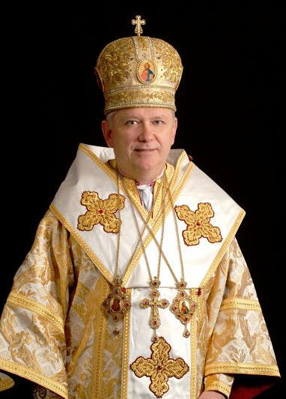
Born: June 1, 1956
Ordained Priest: May 23, 1987
Ordained Bishop and Enthroned Third Bishop of Van Nuys: April 23, 2002
Enthroned as Fourth Bishop of Passaic: January 29, 2008
Enthroned Fifth Metropolitan Archbishop of the Archepharchy of Pittsburgh
: April 18, 2012
Byzantine Catholic Eparchy of Passaic, New Jersey
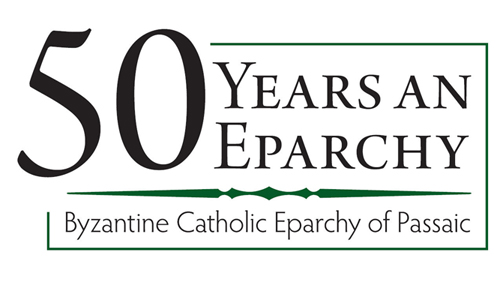
Apostolic Exarch Basil Takach (Takacs)
First Bishop of Passaic
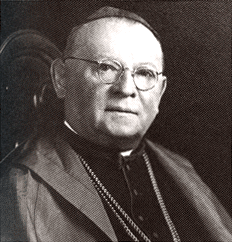
Born: 10/27/1879
Ordained: 12/14/1902
Episcopal Ordination: 6/15/1924
Died: 5/13/1948
Basil Takach was born in a village in Maramoroš County on October 27, 1879. He attended the Uzhorod Seminary as his father and uncle had and was ordained on December 14, 1902. After nine years serving in various parishes, Bishop Julius Firczak appointed Father Takach controller of the Eparchial bank and executive officer of its printing society. After World War I, Father Takach assumed the role of spiritual director of the seminary, professor of religion at the Eparchial teacher's college, member of the matrimonial tribunal and diocesan consultor. During this period, he was selected as the new bishop for the newly established Greek Catholic Exarchate in the United States.
The news of this was very well received by the immigrant Carpatho-Rusin community. Father Takach was ordained as a Bishop in Rome on Pentecost Sunday, June 15, 1924. Later, he sailed on the ocean liner Mauretania for the United States. On August 13, 1924, a large crowd met him at the pier of New York Harbor. After performing a service of thanksgiving at St. Mary's Greek Catholic Church in New York, Bishop Takach set about the task of organizing the new Exarchate. Bishop Takach designated a permanent episcopal seat and residence. The papal bull appointing Father Takach as bishop stated the episcopal seat of the Greek Catholic Exarchate would be New York City. Bishop Takach established temporary residences, first in Trenton, New Jersey, and later in Uniontown, Pennsylvania as this was considered a more suitable location for his episcopal seat. Representatives from St. John the Baptist Greek Catholic Church in Homestead/Munhall, Pennsylvania met with Bishop Takach and presented him with a formal written proposal offering land and assistance if he would establish his residence and episcopal seat at the parish. Bishop Takach accepted the generous offer and designated St. John's as the cathedral of the new Greek Catholic Exarchate. In December 1925, the bishop's residence and chancery were completed. In February 1926, Bishop Takach officially took up residence in Munhall across the street from his new cathedral.
With the creation of the administrative structure for the new Exarchate, Bishop Takach required the clergy to conduct a census of all parishes. The census showed the new Pittsburgh Greek Catholic Exarchate consisted of almost 300,000 faithful organized into 155 parishes and mission churches served by 129 priests. During Bishop Takach’s administration the Holy See issued a decree entitled Cum Data Fuerit. Bishop Takach vehemently opposed the new decree and used all possible means to persuade the Holy See to reverse its decision. When the Holy See rebuffed all appeals, Bishop Takach insisted that the celibacy decree must be obeyed. Bishop Takach worked tirelessly for twenty four years as the first bishop of the Pittsburgh Greek Catholic Exarchate. Bishop Takach died on May 13, 1948 at sixty-nine years of age. A solemn Hierarchical Requiem Liturgy at St. John’s Cathedral was attended by seven bishops, three abbots, one hundred and eighty priests and scores of civil, fraternal, cultural leaders and unknown numbers of the faithful. He was buried in Calvary Cemetery at Mount Saint Macrina, Uniontown, Pennsylvania.
His Grace Michael J. Dudick
Second Bishop of Passaic
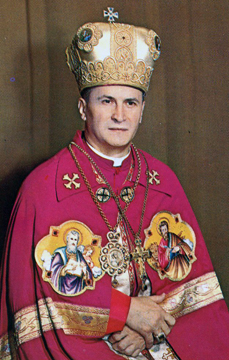
Born: February 24, 1914
Ordained: November 14, 1935
Enthroned Bishop of Passaic: October 24, 1968
Died: May 30, 2007
Michael Joseph Dudick was born February 24, 1916 to Rusyn immigrant parents in St. Clair, Pennsylvania. He attended public schools in Pennsylvania and then attended Illinois Benedictine College and St. Procopius Seminary in Lisle, Illinois. He was ordained to the priesthood on November 14, 1945 by Bishop Basil Takach at St. John the Baptist Byzantine Catholic Cathedral in Munhall, Pennsylvania. He served parishes in Pennsylvania and Ohio.
Pope Paul VI conferred the rank of Right Reverend Monsignor on October 25, 1963. He was ordained a bishop and enthroned on October 24, 1968 as the second bishop of the Byzantine Catholic Eparchy of Passaic in Saint Michael’s Cathedral, Passaic. Bishop Dudick served as a member of the Congregation for the Oriental Churches and was a member of the Committee for the Revision of Eastern Canon Law. He also served on the Board of Overseers for Harvard University and on the Board of Regents of Seton Hall University, South Orange, New Jersey.
Bishop Dudick retired as bishop of Passaic in 1995. He died at age 91 on May 30, 2007. He is buried in the cemetery of Mount Saint Macrina Monastery in Uniontown, Pennsylvania.
His Excellency, Most Reverend Andrew Pataki, J.C.L., D.D
Third Bishop of Passaic
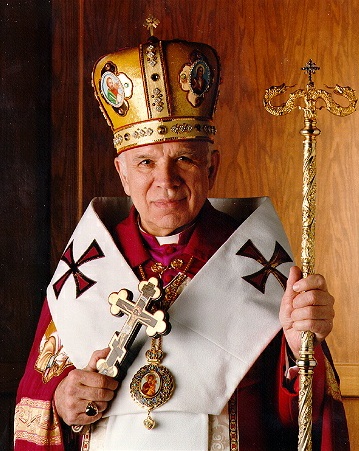
Born: August 30, 1927
Ordained: February 24, 1952
Enthroned Bishop of Passaic: February 8, 1996
Died: December 8, 2011
His Excellency, Most Reverend Andrew Pataki, J.C.L., D.D., Bishop Emeritus of the Byzantine Catholic Eparchy of Passaic, passed away on Thursday, December 8, 2011 at Jersey Shore University Medical Center, Neptune, NJ from injuries sustained in a motor vehicle accident.
Bishop Andrew Pataki was born in Palmerton, PA on August 30, 1927 of the late Ignatius and Sophie (Dejak) Pataki. Following his early education in the Palmerton Public Schools, and Central Catholic High School in Allentown, PA, he enrolled in Saint Vincent’s College, Latrobe, PA. In 1944, he began his studies for the priesthood. He graduated from Saint Procopius College-Seminary in Lisle, Illinois with a Bachelor of Arts Degree in Philosophy in 1948. He completed his theological studies at the Byzantine Catholic Seminary of Saints Cyril and Methodius in Pittsburgh, PA. He was ordained to the priesthood in the Byzantine Seminary Chapel by the Bishop Daniel Evancho, Exarch of Pittsburgh, on February 24, 1952.
Among his early assignments as a priest were at Saints Peter and Paul Church, Braddock, PA; Saint Pius X Church, Pittsburgh, PA; Saints Peter and Paul Church in Endicott, NY; and at Saint Nicholas Church in Lorain, OH. During his eight years as pastor there, he constructed a parochial school and convent. He was later appointed Pastor of Saint John Chrysostom Church in Pittsburgh, PA. He was sent to Rome, Italy to pursue graduate studies in Canon Law at the Pontifical Institute for Oriental Studies where he received Bachelor and Licentiate Degrees in Canon Law. After returning home, he was appointed Rector of the Byzantine Catholic Seminary in Pittsburgh, PA, where he taught courses in Pastoral Theology, Canon Law, Byzantine Chant and the Ruthenian Language.
In 1974, Pope Paul VI designated him a Monsignor, with the rank of Prelate of Honor and appointed him a consultor on the Pontifical Commission for the Revision of the Eastern Code of Canon Law. In 1979, he was appointed the Pastor of Saint Mary’s Church, Weirton, W. VA. His assignments in the Archeparchy of Pittsburgh included: Defender of the Bond on the Matrimonial Tribunal, Director of the Society of the Sacred Heart, Chairman of the Liturgical Commission, Vice Chancellor, Chancellor and Consultor.
On June 14th, 1983, Monsignor Andrew Pataki was named the Auxiliary Bishop to the Bishop of the Byzantine Catholic Eparchy of Passaic, Bishop Michael J. Dudick. He was consecrated a Bishop on August 23, 1983 at Saint Peter’s Roman Catholic Cathedral in Scranton, PA. The following year, he was appointed the second Bishop of the Eparchy of Parma, OH. During his 11-year tenure there, he established three regional syncellates (Episcopal Vicariates) and appointed a Syncellus (Episcopal Vicar) for each. He also promulgated a standardized form of the Divine Liturgy of Saint John Chrysostom and of the Presanctified Liturgy. He initiated a five-year process for an Eparchial Assembly, promulgated the statutes proposed by that Assembly, established a Presbyteral Council, a Protopresbyteral Council, a Pastoral Council, a Finance Council and a Cantor’s Institute. He established the Eparchy on a firm financial foundation and by 1991 was thus able to make a substantial gift of $235,952.00 to the newly reestablished Eparchy of Mukachevo in present-day Ukraine.
On November 21, 1995, the Vatican announced that Bishop Andrew Pataki was appointed the Bishop of the Eparchy of Passaic, NJ. Hundreds of well wishers crowded the Cathedral of Saint Michael the Archangel in Passaic, NJ on Thursday afternoon, February 8, 1996 to join in the enthronement Hierarchical Divine Liturgy making Bishop Andrew the third Bishop of Passaic. His Excellency, Archbishop Agostino Cacciavillan, Apostolic Pro-Nuncio to the United States, read the Bulla of Pope John Paul II appointing Bishop Andrew to head the Passaic Eparchy. The Bulla stated: “Since you, venerable brother; endowed as you are with outstanding qualities of mind and heart and very experienced in ecclesiastical matters and those of Canon Law seemed suitable to govern it we release you from the bond of the already-mentioned eparchial see (ie, Parma), and we appoint you Bishop of the Eparchy of Passaic of the Ruthenians with all rights granted and obligations imposed which belong to this office.”
As the Bishop of the Eparchy of Passaic, Bishop Andrew established a new governing structure for the Eparchy by dividing it into six Syncellates and appointing a Syncellus for each. Each Syncellus was given wide canonical powers for granting dispensations and permissions. He promulgated a standardized form of the Liturgy of Saint John Chrysostom, the Presanctified Liturgy and the Sacraments of Initiation. In this last, he restored the ancient practice of giving the Holy Eucharist to everyone, including babies, at the time of Baptism. He reorganized most of the Eparchial Commissions and Programs. He established a Diaconate Formation Program. He reestablished the ancient tradition of the Byzantine Clergy wearing pectoral crosses and conferred a beautiful Greek-styled cross on each priest in September of 2000. He established a separate Marriage Jubilee celebration in each of the six Syncellates.
Bishop Andrew was named by his fellow Bishops of the Metropolitan Church of Pittsburgh to be the Episcopal Chair for the Inter-Eparchial Canon Law Commission. This Commission helped to formulate the Particular Law for our Metropolitan Church – the first of its kind among the Eastern Catholic Churches of the world. It became effective on October 1, 1999. Upon the death of Metropolitan Judson Procyk in April of 2001, Bishop Andrew; because he was the senior Bishop according to Episcopal ordination, automatically became the Acting Metropolitan of the Metropolitan Church of Pittsburgh sui iuris until a new Metropolitan Archbishop was installed.
At the age of 80, in 2007, his request for retirement was accepted by Pope Benedict XVI.
After retirement, Bishop Andrew remained active in ministry. He served at St. George Byzantine Catholic Church in Linden and was the Administrator of St. Nicholas Byzantine Catholic Church, Perth Amboy, until his death.
Bishop Andrew was preceded in death by his parents, Ignatius and Sophie, also by a brother, Ignatius Pataki, Jr., Sisters Mary Kern, Sophia Iliades, Ann Roberts and Julianna Gamble. He is survived by brothers Deacon Michael Pataki and wife Annetta, Mountaintop, PA; Charles Pataki and wife Betty, Cincinnati, OH; sisters Helen Hahn, Ellicott City, MD; and Peggy Rendesh, Hope Mills, NC and in addition numerous nieces and nephews.
The reception of the Bishop’s body will be Tuesday, December 13, 2011, 5 PM at the Cathedral of St. Michael the Archangel, 96 First St., Passaic. The bishop will lie in state from 5:30-7 PM with services at 7 PM. Wednesday the Bishop will lie in state at the Cathedral, 10AM-1PM, and 6-7 PM with services at 7 PM. Funeral services will be Thursday December 15, 2011 10 AM with Hierarchical Funeral Divine Liturgy for a Bishop and pouring of oil with Panachida. Interment will be at Calvary Cemetery in Uniontown, PA on Friday at 1 PM. Arrangements under the direction of the Shook Funeral Home, 639 Van Houten Ave., Clifton.
His Eminence Most Reverend William C. Skurla, D.D.
Fourth Bishop of the Eparchy of Passaic
Current Metropolitan Archbishop of Pittsburgh
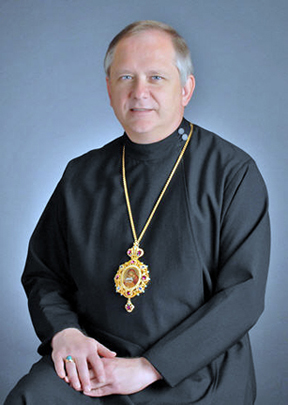
Born: June 1, 1956
Ordained Priest: May 23, 1987
Ordained Bishop and Enthroned Third Bishop of Van Nuys: April 23, 2002
Enthroned as Fourth Bishop of Passaic: January 29, 2008
Enthroned Fifth Metropolitan Archbishop of the Archepharchy of Pittsburgh
: April 18, 2012
Metropolitan Archbishop William Charles Skurla, D.D. was born in Duluth, Minnesota June 1, 1956. He is the son of the late John and Mavis Skurla. He attended Catholic and public elementary schools and graduated in 1974 from Chisholm High School, Chisholm, Minnesota.
Bishop William attended Deerfield Academy Post-Graduate program in Deerfield, Massachusetts 1974-75 and then attended Columbia University in New York City, graduating with a concentration in Philosophy in 1981. Following this, he then studied at Mary Immaculate Seminary in Northampton, Pennsylvania receiving Master of Divinity (1986) and Master of Theology (1987) degrees.
Discerning a call to serve the Lord in a special way, William Skurla entered the Byzantine Franciscan community in Sybertsville, Pennsylvania in 1981 and was solemnly professed in 1985. Bishop Michael Dudick ordained him to the diaconate in 1986 and to the priesthood in 1987 at St. Mary Byzantine Catholic Church in Freeland, Pennsylvania. In 1996, having received and accepted his dispensation from solemn vows as a member of the Order of Friars Minor (OFM), he was incardinated into the Eparchy of Van Nuys, where he served as Pastoral Administrator at St. Melany Byzantine Catholic Church in Tucson, Arizona from 1993 until 2002.
Metropolitan Archbishop William was ordained to the Episcopacy and enthroned as the Third Bishop of the Byzantine Catholic Eparchy of Van Nuys (now the Eparchy of Phoenix) on April 23, 2002 in Phoenix, Arizona. In December 2007 he was appointed Fourth Bishop of the Eparchy of Passaic (N.J.) and was enthroned at St. Michael Cathedral in Passaic on Jan. 29, 2008.
The Episcopal chairperson of the Intereparchial Vocations Commission (IEVC) and Intereparchial Youth Commission for the Metropolitan Church, Bishop William was a member of the Committee on the Laity with the United States Conference of Catholic Bishops (USCCB). He currently serves as a member of the USCCB Administrative Committee, Priority and Plans Committee, and National Advisory Committee.
Metropolitan Archbishop William was appointed fifth Metropolitan of the Byzantine Catholic Ruthenian Church in America by His Holiness Pope Benedict XVI on Jan. 19, 2012.
His Grace, Most Reverend Kurt R. Burnette
Fifth Bishop of the Eparchy of Passaic
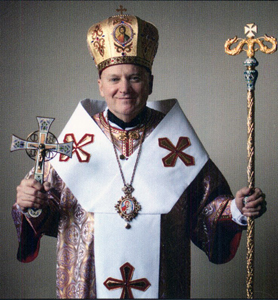
Born: November 7, 1955
Ordained a Priest: April 26, 1989
Appointed Bishop of Passaic: October 29, 2013
Enthroned as Bishop of Passaic: December 4, 2013
Born at Sculthorpe Royal Air Force Base, Norfolk, England, Bishop Burnette attended various universities and received a doctorate in mathematics and was employed as a professor. Bishop Burnette was ordained to the Holy Priesthood at Saint Mary Cathedral in Sherman Oaks, California on April 26, 1989 by the late Bishop John M. Bilock. He served as pastor in parishes in New Mexico, Nevada, Oregon, California and earned a licentiate in canon law at the Pontifical Oriental Institute. Bishop Burnette was appointed rector of Saints Cyril and Methodius Byzantine Catholic Seminary in Pittsburgh, Pennsylvania during October, 2012. On October 29, 2013, The Apostolic Nuncio, Archbishop Carlo Maria Vigano announced that Pope Francis appointed Bishop Burnette as the Fifth Bishop of the Byzantine Catholic Eparchy of Passaic.
Ordination and Enthronement of Bishop Kurt Burnette, Fifth Bishop of the Byzantine Catholic Eparchy of Passaic (Available on UTube-Part 1 OFF-SITE)
Ordination and Enthronement of Bishop Kurt Burnette, Fifth Bishop of the Byzantine Catholic Eparchy of Passaic(Available on UTube-Part 1 OFF-SITE)
Byzantine Catholic Epharchy of Parma, Ohio
Bishop Emil John Mihalik
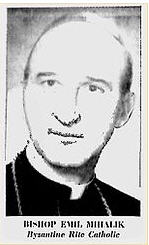
Emil John Mihalik was the second child of William and Mary (nee Jubic) Mihalik. His father was baptized Basil Mihalik in the Carpatho-Rusyn village of Hrabske Slovakia at St. Dimitri the Martyr Greek Catholic Church. He changed his name to William once in the U.S. Basil was the son of John Mihalik a local farmer from Hrabske and Maria Fignar from the same village. In 1910 at the age of eighteen he immigrated to America settling in Windber, Pennsylvania. He married Pennsylvania born Mary Jubic the daughter of William and Julia (Berdy) Jubic. William and Mary’s first child Anna Mihalik was born July 16, 1917 in Pittsburgh, Pennsylvania. Emil was born on February 7, 1920 also in Pittsburgh. As of 1920 William was residing with his family in Pittsburgh and he was employed as a butcher in a local retail shop. By 1930 and to 1940 he was working as a butcher in a meat packing plant. Mary too was employed by 1940 as a clerk in a retail bakery store. Between 1920 and 1930 the family rented their residence on Newton Street in Pittsburgh. They later moved to the Brentwood Borough of Pittsburgh residing on Hilson Avenue by 1940. Mary Mihalik passed away on December 4, 1990 in Parma, Ohio at her son’s residence. William preceded her in death.
Emil received his education in the Pittsburgh public school system and graduated from Brentwood High School. Upon graduation from high school he entered the Catholic Institute in Pittsburgh to prepare for his seminary training. Later, he was accepted at Saint Procopius College and Benedictine Seminary in Lisle, Illinois. He was ordained a priest at Saint Mary’s Greek Catholic Church in Trenton, New Jersey on September 21, 1945 by Bishop Basil Takach.
His first assignment was as assistant pastor at a parish in Hazleton, Pennsylvania. After serving in Hazleton he was transferred to Saints Peter and Paul Byzantine Catholic church in Struthers, Ohio as Administrator. During his tenure at Saints Peter and Paul he managed the construction of Byzantine Catholic Central High School in Youngstown. He served as Administrator of Saints Peter and Paul Byzantine Catholic Church in Endicott, New York and was pastor of Saint Thomas Byzantine Catholic Church in Rahway, New Jersey from February 1, 1961 to June 12, 1969. In 1968 he was named the Chancellor for the Byzantine Catholic Eparchy of Passaic.
His Holiness, Pope Paul VI created the Eparchy of Parma Ohio on February 21, 1969. Archbishop Luigi Raimondi the Apostolic Delegate to the United States announced the creation of the new Byzantine Catholic Eparchy. Father Mihalik’s appointment as Bishop was effective on March 12, 1969. The new Eparchy would encompass most of Ohio and 24 other states. Bishop Mihalik was enthroned as Bishop on June 12, 1969. The main celebrant at Bishop Mihalk’s installation was Archbishop Stephen Kocisko. Con-celebrants were Bishop Michael Dudick and Bishop Michael Rusnak. The services were held at the newly constructed Cathedral of Saint John the Baptist in Parma, Ohio.
Bishop Mihalik started work immediately to construct new churches and provide priests for his Eparchy. During his tenure, approximately 18 new churches were constructed and he ordained twenty-three priests. He also assisted with the establishment of a new order of Sisters, the Byzantine Nuns of St. Clare. On September 6, 1970 during the annual pilgrimage to Our Lady of Perpetual Help at Mount Saint Macrina in Uniontown, Pennsylvania, Archbishop Stephen Kocisko, Bishop Emil Mihalik and Bishop Michael Dudick blessed a new cornerstone for a multi-bed nursing home managed by the Sisters of Saint Basil. During this pilgrimage, over 45,000 people were in attendance.
During May of 1977, Bishop Alden Bell of the Roman Catholic Diocese of Sacramento gave over $20,000 which had been a World War II fund for Slovaks to Bishop Mihalik. The Bishop dedicated these funds for the construction of a church in Sacramento, California. The Eparchy of Parma continued to expand rapidly. In 1982, the Vatican re-organized the diocese and incorporated thirteen of the western states of the Eparchy into the newly created Eparchy of Van Nuys, California.
On January 27, 1984 Bishop Emil Mihalik died of lung cancer at Saint Vincent Charity Hospital and Health Center in Cleveland, Ohio. He was 63 years old. Metropolitan Archbishop Stephen Kocisko officiated at the funeral mass at Saint John the Baptist Byzantine Catholic Cathedral, Parma, Ohio. Numerous clergy and faithful attended the services. Monsignor Andrew Vaida was named diocesan administrator until a new Bishop could be named. Funeral services for a Bishop of the Byzantine Catholic Church were celebrated in the partially renovated Cathedral in Parma, Ohio on March 1, 1984. Bishop Mihalik was interred at Calvary Cemetery of Mount Saint Macrina in Uniontown, Pennsylvania. His final resting place is to the right of Bishop Basil Takach. Bishop Takach ordained Bishop Emil Mihalik to the priesthood in 1945. In recognition of his service, on December 8, 2009 Bishop John Kudrick of the Eparchy of Parma dedicated the new Bishop Emil J. Mihalik Byzantine Catholic Cultural Center and Museum. The Museum is dedicated to the history of the Eparchy of Parma, its churches, parishioners and priests of the Eparchy.
Photo Credit (Rob Tomcanin findagrave.com)
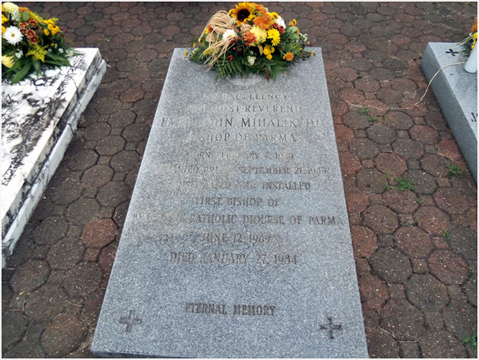
Apostolic Administrator/Bishop Milan Lach
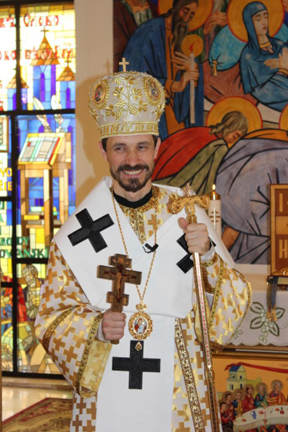 On the Holy Day of Saint John the Baptist, Saturday, June 24, 2017, the Holy Father, Pope Francis, appointed Bishop Milan Lach, S.J., as Apostolic Administrator for the Byzantine Catholic Eparchy of Parma, Ohio. He had been serving as the auxiliary bishop of the Greek Catholic Archeparhcy of Prešov, Slovakia. His maternal great-grandfather was born in the area near Chicago, Illinois but returned with his family to their Carpatho-Rusyn village of Osturna, former Spiš District, present day Kezmarok District, in Eastern Slovakia. Milan Lach was born in Kezmarok, Slovakia on November 18, 1973. He was educated at the Greek Catholic Theological Faculty of Prešov and in 1995 entered the Jesuit novitiate in Trnava.
On the Holy Day of Saint John the Baptist, Saturday, June 24, 2017, the Holy Father, Pope Francis, appointed Bishop Milan Lach, S.J., as Apostolic Administrator for the Byzantine Catholic Eparchy of Parma, Ohio. He had been serving as the auxiliary bishop of the Greek Catholic Archeparhcy of Prešov, Slovakia. His maternal great-grandfather was born in the area near Chicago, Illinois but returned with his family to their Carpatho-Rusyn village of Osturna, former Spiš District, present day Kezmarok District, in Eastern Slovakia. Milan Lach was born in Kezmarok, Slovakia on November 18, 1973. He was educated at the Greek Catholic Theological Faculty of Prešov and in 1995 entered the Jesuit novitiate in Trnava.
He was ordained a Deacon on November 11, 2000 and as a Jesuit scholastic he earned a degree in theology. He was ordained a Greek Catholic priest of the Society of Jesus on July 1, 2001 in Košice. From 2001 to 2003 Bishop Lach studied at the Center of Spirituality East-West of Michal Lacko in Košice and later (2009-2011) he was Superior of the same center; he also studied at Rome’s Pontifical Oriental Institute. Among the other ministries he engaged he was the spiritual father at the Pontifical Collegium Russicum and also as spiritual assistant of the Federation of Scouts of Europe in Rome.
On April 19, 2013, Pope Francis appointed Bishop Lach as auxiliary bishop of the Greek Catholic Archeparchy of Prešov, Slovakia. Since 2016 he has been visitor of the Congregation for the Oriental Churches of the Seminaries and Oriental Colleges in Rome. Bishop Milan Lach has visited the United States on a number of occasions and speaks English along with Slovak. The Eparchy of Parma bishops’ seat has been vacant since 2016 and it covers parishes in 12 states. The 44 year old Greek Catholic Jesuit is the first European-born bishop to serve the Byzantine Catholic Eparchy of Parma, Ohio.
Pioneer Greek Catholic Priestly Families
Reverend Father Elias Gojdic
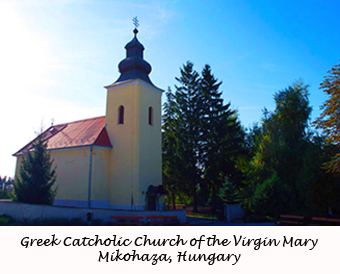
Elias Gojdic was born July 28, 1872 in Mikohaza, Hungary. He was the son of Stephen Gojdics and Maria Thekla Janovich. Elias’ father and grandfather had served as cantors. Prior to his ordination Elias married the former Maria Happel. He was ordained a Greek Catholic priest at Saint John’s Greek Catholic Cathedral, Presov, Slovakia on December 9, 1896. He served the Greek Catholic village church of Chorvaty, Slovakia from 1896 to 1902. In 1902 he immigrated to the United States and served Greek Catholic churches in America from 1902 to 1931. Father Gojdic was the founding pastor of SS Peter & Paul Greek Catholic Church in Portage, Pennsylvania in 1917. From 1924-1931 Father Gojdics was the pastor of Saint Michael Greek Catholic Church in Hermitage, Pennsylvania until his death in 1931. He was interred at Saint Michael Byzantine Catholic Cemetery in Hermitage. His beloved wife Pani Maria died in 1957. Father Elias and Pani Mary were the parents of: Maria Olga (1897-?); Helen Maria Large (1898-1936); Mary Anna (1900-1983); Olga (1902-1971); Anne (1904-1988); Margaret Large (1906-?); Elias (1907-1974); and John (1908-1974).
Reverend Father Stephen Janicky
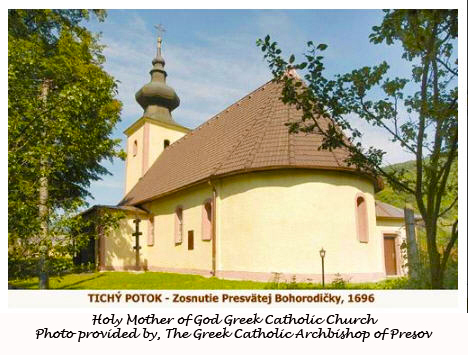
Stephen Janicky was born in Tichy Potok, Slovakia in 1852 into a Greek Catholic priestly family. He was one of 11 children born to the Reverend Father Antonius Janiczky (son of Reverend Father Elias Janiczky and Anna Kubek) and Amelia Ilykovics (the daughter of Reverend Father Joseph Ilykovics). Prior to his ordination he married the former Helena Rokiczky of Porubka, Slovakia (the daughter of Reverend Father Anton Rokiczky) on the 19th of February 1877 at Saint John’s Greek Catholic Cathedral in Presov, Slovakia. Stefan was ordained a Greek Catholic priest at Saint John’s Greek Catholic Cathedral in Presov on March 22, 1877. He served in the Greek Catholic village church of Homrogd in 1877, then in Torysky from 1877 to 1878 and Sulin from 1878 to 1908. Father Stefan immigrated to the United States and served various Greek Catholic churches in America from 1908 to 1931. He was appointed the full time pastor of Saint Michael’s Greek Catholic Church in McAdoo, Pennsylvania in 1909. He served the faithful of this parish for a full twenty-three years. He proved to be a zealous and faithful leader. He paid off the cost of the wooden church, erected the rectory and purchased a cemetery. The parish thrived under Father Janicky’s good guidance. He died on March 18, 1931 one year after observing his golden jubilee. During his tenure as resident priest of St. Michael’s Father Stefan also served at St. Mary’s Greek Catholic Church in Hazleton, Pennsylvania in 1914 and again from November 1916 to April of 1917. Father Stefan and Pani Helena were the parents of three children: Rev. Father Irenej Janiczky (1878-?); Helena (1880-?); and Olga (1883-1979), the wife of Revered Father Nicholas Marytak.
Reverend Father Irenej Janicky
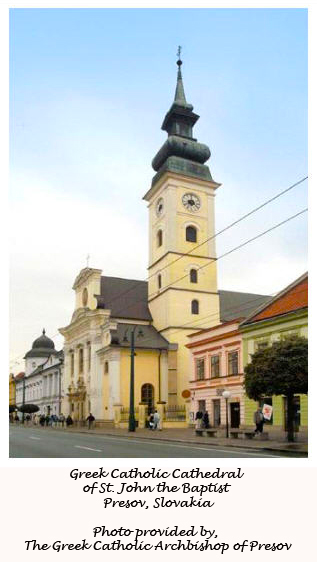
Irenej Janicky was born in Presov, Slovakia on April 28, 1878 into a Greek Catholic priestly family. He was one of three children born to the Reverend Father Stephen Janicky and Helen Rokiczky. He married Maria Kubek of Kruzlov, Slovakia, the daughter of Reverend Father A. Emil Kubek and Irma Maria Schirilla. (Irma Maria Schirilla was the daughter of Reverend Father Edward Schirilla and Clementine Pankovics). He was ordained a Greek Catholic priest at Saint John’s Greek Catholic Cathedral, Presov, Slovakia on August 26, 1900. He served at Sts. Cosmos & Damien Greek Catholic village church in Maly Lipnik, Slovakia from 1900 to 1904. He immigrated to the United States in 1904 and served at Saint Michael’s Greek Catholic Church in Passaic, New Jersey from 1905 to 1915 and again during 1917. In 1920 he was serving at St. Mary’s Greek Catholic Church in Trenton, New Jersey. In 1922 he returned to Slovakia and served the Greek Catholic village churches of Nizna Pisana 1922 to 1930 and Sulin from 1930 to 1936. Father Irenej and Pani Janicky were the parents of two sons, Sandor and Alexander. Father Janicky’s sister Olga (1883-1979) was the wife of Revered Father Nicholas Marytak.
Reverend Father Emil A. Kubek
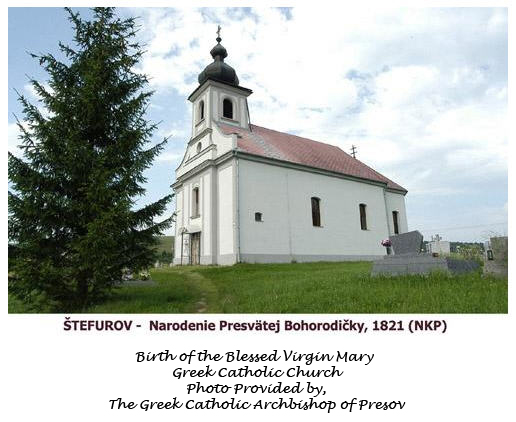
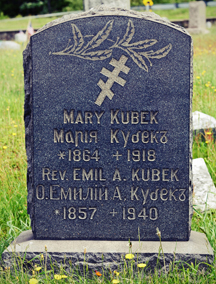
Gravestone photo from findagrave.com contributor, Norm Richards
Reverend Kubek was born November 28, 1857 in the village of Stefurov, Slovakia. He was the son of the village parish priest Rev. Antonius Kubek and Pani Wilhelmina Kiss. Rev. Kubek died on June 17, 1940 in Mahanoy City, Schuylkill County, Pennsylvania. He was laid to rest at Saint Mary's Greek (Byzantine) Catholic Cemetery in Mahanoy City, Pennsylvania.
He was the husband of the late Irma Maria Schirila, daughter of Rev. Edward and Clementine (Pankovics) Schirila.
Father and Pani Kubek were the parents of Emil; Maria, wife of Rev. Irenej Janiczky; Rev. Anthony Edward 'Emil' Kubek; Anna, Gabriella, and Elizabeth Kubek.
He was ordained a Greek Catholioc priest at Saint John's Greek Catholic Cathedral, Presov on March 22, 1881, served at the following village churches in Slovakia: 1881-1882 Homrogd, 1883-1883 Jakubany, 1884- 1884 Kremna, 1884-1885 Ruske Peklany and 1885-1898 Snakov. While the parish priest in Snakov Father Kubek, who was an accomplished agronomist, taught his parishioners the art of keeping and raising bees and how to grow various crops. He immigrated to the United States and served at Saint Marys Greek Catholic Church in Mahanoy City, PA from 1904 to 1940. He was an author of various novels, poems and published the only novel in his native Presov dialect (Rusnak) "Marko Solyts" and also penned Narodny Povisti I Stichi which was a four volume set of tales and poems which was published by Okrana in Scranton, PA (1922-1923). His most important work was considered his dictionary in Slavonic-Rusnak-Hungarian.
Right Reverend Monsignor Gabriel Martyak
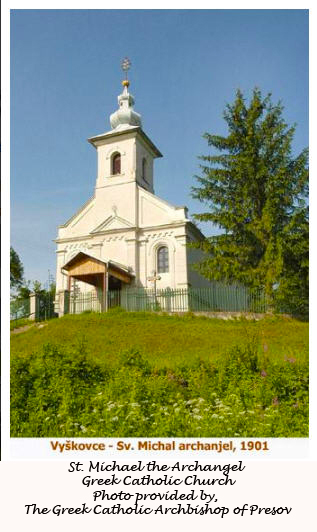
Gabriel Martyak was born on November 3, 1859 in Vyskovce, Slovakia into a Greek Catholic priestly family. He was the son of Reverend Father John Martyak (son of Reverend Father Basil Martyak and Catherine Janovics) and Melania Sztavroszky. Prior to his ordination he married the former Irene Dudinszky. He was ordained a Greek Catholic priest at Saint John’s Greek Catholic Cathedral, Presov, Slovakia on February 15, 1885. He served the Greek Catholic village churches in Jarabina, 1885 to 1886 and Kobylnice from 1886 to 1895. Father Gabriel and Pani Irene were the parents of six children: Nicholas (1885-1886); Mary (1887-1961), wife of Rev. Emil Semetkovsky; Gabriella (1889-?), wife of Rev. Zigmund Brinsky; Olga Gyulay (1890-?); Albin (1893-?); and John (1895-?). The family immigrated to the United States in 1894. Father Gabriel served at St. John the Baptist Greek Catholic Church in Lansford, Pennsylvania from 1895 until his death in 1934. From January 1898 to August 1903 he was pastor of St. Mary’s Greek Catholic Church in Freeland, Pennsylvania. In 1903 he returned to Slovakia and served Greek Catholic churches in Bardejov, 1903 to 1910, Beloveza, 1905 to 1906 and Andrejova, 1905 to 1908. He returned to the United States and served Greek Catholic churches, including Saint Mary’s Protection Greek Catholic Church in Homer City, Pennsylvania, from 1910 to 1934. In 1920 The Very Reverend Gabriel Martyak was instrumental in assisting Mother Macrina Melynychuk the first Ruthenian Greek Catholic Convent of the Order of Saint Basil the Great. In 1916 Right Reverend Monsignor Martyak was appointed Apostolic Administrator of the Ruthenian Greek Catholic Church in the United States. He held this position until 1924. Rt. Rev. Msgr. Martyak died on April 16, 1934 in Lansford, Pennsylvania. His wife Pani Irene preceded him in death. Father Gabriel was the brother of Father Viktor Martyak and Father Nicholas Martyak.
Reverend Father Nicholas Martyak
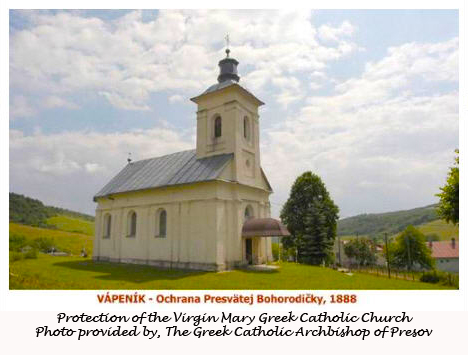
Nicholas Martyak was born on July 16, 1879 in Vapenik, Slovakia into a Greek Catholic priestly family. He was the son of Reverend Father John Martyak (son of Reverend Father Basil Martyak and Catherine Janovics) and Melania Sztavroszky. Father Martyak advanced so rapidly while studying at the diocesan seminary in Presov that prior to his ordination he held the position of Professor of Catechetics on the staff of the Presov Preparatory School for Teachers for a year.
In keeping with the traditions of his faith, Father Martyak was wed prior to his ordination. On August 12, 1902 he married the former Olga Janiczky, youngest daughter of Reverend Father Stephen Janiczky and Helen Rokiczky. Father Martyak was ordained September 14, 1902 by Most Rev. John Valyi, D.D., Bishop of Presov Diocese. On September 28 he celebrated his first solemn high mass in the Church of St. Michael the Archangel in the village of Sulin. He served at the Greek Catholic Church in Krempach, Slovakia from 1903-1904 and at Sts. Cosmos and Damien Greek Catholic Church in Maly Lipnik, Slovakia from 1904-1907.
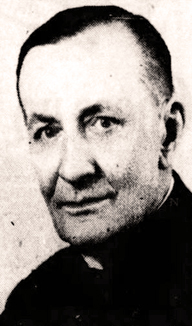
Fr. Nicholas immigrated to the United States in 1907. Upon arrival in the U.S. Father Martyak served at St. Mary's Greek Catholic Church in McAdoo, Pennsylvania for two months. In December of 1907 he became the pastor of St. John the Baptist Greek Catholic Church in Hazleton, Pennsylvania. Father Martyak’s pastorate at St. John’s spanned 47 years until his death in 1954. He died on February 1, 1954 in Hazleton.
As pastor of St. John's Father Martyak took a congregation of 200 families and built the parish to well over 500 families. When he came to St. John's there was a mortgage of $3,000 which he quickly liquidated. Soon after he remodled the church, added stained glass windows and extended the church by an additional 24-feet. On September 7, 1908 rededication ceremonies were performed by Rt. Rev. Bishop Ortynsky.
The remodeling of the rectory and the construction of a parish school on North Wyoming Street was undertaken. On July 4, 1932, the new school was blessed by Rt. Rev. Bishop Takach. The Sisters of St. Basil the Great were assigned to conduct the school. This structure at a cost of $120,000 (in today's dollars approximately two million dollars) also provided for a parish hall which contributed much to the areas social and cultural life.
In 1933 a convent was built on the lot adjoining the school.
Over the years the parish cemetery, of personal pride to Father Martyak was also expanded and improved.
Father Martyak's wife Pani Olga died on June 14, 1979. Father Nicholas and Pani Olga were the parents of six children: Anne M. (1904-1967), wife of Rev. Igor M. Maczkov; Dr. Emil Thomas Martyak (1906-1989; Helen M. (1907-1954); Stephen G. (1910-1912); Dr. Gabriel Martyak (1915-2000); and Bart Martyak. Father Nicholas was the brother of Right Reverend Monsignor Gabriel Martyak and Father Viktor Martyak. At the time of his death he was also survived by a sister, Helena Martyak of Presov, Slovakia.
Reverend Father Viktor Martyak
Viktor Martyak was born on April 4, 1865 in Vel’ka Pol’ana in Slovakia into a Greek Catholic priestly family. He was the son of Reverend Father John Martyak (son of Reverend Father Basil Martyak and Catherine Janovics) and Melania Sztavroszky. Prior to his ordination he married the former Vilma Maria Petrasovszky. Vilma Maria was the daughter of Reverend Father Joseph Petrasovszky. Father Martyak was ordained a Greek Catholic priest at Saint John’s Greek Catholic Cathedral, Presov, Slovakia on September 19, 1891. He served in the Greek Catholic village church of Korunkova, 1891 to 1893. He immigrated to the United States with his wife Maria and served Greek Catholic churches from 1893 to 1901. In 1893 Father Viktor was the first priest to serve St. John the Baptist Greek Catholic Church in Hazleton, Pennsylvania. He was instrumental in the organization and growth of SS Peter and Paul Greek Catholic Church in Beaver Meadows, Pennsylvania. He returned to Slovakia and served Greek Catholic village churches in Cukalovce, 1901 to 1905 and Hostovice, 1905 to 1937. Father Viktor and Pani Vilma Maria were the parents of Rev. Alexander John Martyak (1892-?); Anna (1895-1989), wife of Father John Krusko; Nicholas (1899-?); Rev. Paul Martyak (1903-?); and Aranka Dobrovolsky. Father Viktor was the brother of Rev. Monsignor/Apostolic Adminstrator Gabriel Martyak.
Reverend Father Nicholas Molchany
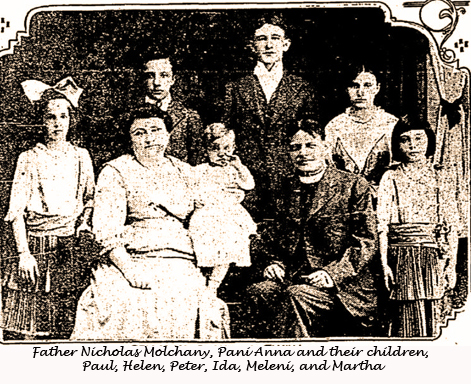
Nicholas Blasius Molchany was born on Febrary 23, 1866 in Bajerovce, Slovakia into a Greek Catholic priestly family. He was the son of Reverend Father Michael Molcsany (son of Reverend Father Michael Molcsany and Francisca Rojkovics) and Emilia Andrejkovics (daughter of Reverend Father John Andrejkovics). Prior to his ordination he married the former Anna Kendrovsky in 1891. Anna was born in 1874 in Medvedzie, Slovakia. She was the daughter of Reverend Father Barthlomew Kendrovsky and Anna Neviczky. Nicholas was ordained a Greek Catholic priest at Saint John’s Greek Catholic Cathedral on November 1, 1891. He served in the Greek Catholic village churches of Sajopetri from 1891 to 1893 and Vysny Kazimir from 1893 to 1894. He immigrated to the United States in 1894. Father Nicholas was pastor of various congregations in Braddock, Pennsylvania; Freeland, Pennsylvania; and Kingston, Pennsylvania. He was pastor of Saint Michaels Greek Catholic Church, Passaic, New Jersey from 1901 to 1906. In each of these parishes new church edifices were erected during his pastorate. His final assignment was at Assumption of the Blessed Virgin Mary Greek Catholic Church in Youngstown, Ohio. Father Nicholas and Pani Anna were the parents of seven children: Dr. Paul (1899-1979); Helen; Rev. Peter Ernest (1902-1990); Ida Bosak 1905-1984; Alice; Meleni; and Martha. Father Nicholas died on January 4, 1918 in Youngstown, Ohio. Pani Anna died several years later on January 27, 1924 in Youngstown. Father Nicholas was the brother of Father Vladimir Molchany.
Reverend Father Vladimir Molchany
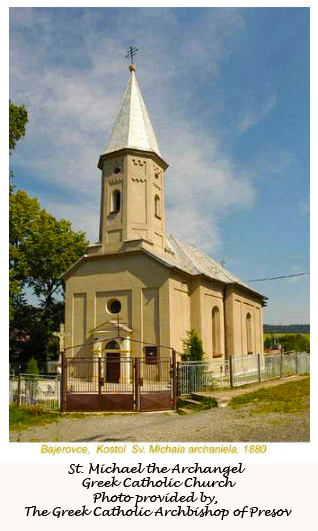
Vladimir Peter Molchany was born in 1856 in Bajerovce, Slovakia into a Greek Catholic priestly family. He was the son of Reverend Father Michael Molcsany (son of Reverend Father Michael Molcsany and Francisca Rojkovics) and Emilia Andrejkovics (daughter of Reverend Father John Andrejkovics). Prior to his ordination he married his cousin the former Anna Adalberta Molchany on September 28, 1880 at the Nativity of the Virgin Mary Greek Catholic Church in Mlynarovce, Slovakia. Anna was the daughter of Reverend Father Anton Molcsani (son of Reverend Father Michael Molcsany and Francisca Rojkovics) and Maria Podhajeczky (daughter of Reverend Father Alexander Podhajeczky and Maria Schirilla). Vladimir was ordained a Greek Catholic priest at Saint John’s Greek Catholic Cathedral, Presov, Slovakia on January 2, 1881. He served in the Greek Catholic village churches of Sobos from 1881 to 1882, Bodogkovaralja, 1882 and Breznicka, 1883 to 1891. In 1891 he immigrated to the United States and served in various Greek Catholic churches in America. As of 1900 he was serving St. Mary’s Greek Catholic Church in Kingston, Pennsylvania. Father Vladimir and Pani Anna Adalberta had four children: Margaret Magdalina (1882-1882); Yolanda (1885-1937), wife of His Eminence Metropolitan Orestes P. Chornock; Stephanie Rachel (1888-1972), wife of Rudolph Oscar Runtagh; and Bertha (1900-1941), wife of Rev. John Daniel Taptich. Father Vladimir died on September 9, 1904 in Cleveland, Ohio. His wife, Pani Anna Adalberta died in Pottstown, Pennsylvania on Dec 20, 1953. Father Vladimir was the brother of Father Nicholas Molchany.
Reverend Father Gabriel Vislocky

Gabriel 'Gabor' Vislocky was born about 1855 in Vapenik, Slovakia into a Greek Catholic priestly family. He was the son of Reverend Father Anton Viszloczky (son of Reverend Father John Viszloczky) and Victoria Kovaliczky. Prior to his ordination he married the former Maria Dzubay. He was ordained a Greek Catholic priest at Saint John’s Greek Catholic Cathedral, Presov, Slovakia on August 27, 1880. He served Greek Catholic village churches in Kamienka from 1880 to 1882; Vysny Mirosov in 1882; Sedliska, 1883 to 1887; and Rafajovce, 1888 to 1890. He immigrated to the United States where he served Greek Catholic churches in Pennsylvania including Saints Cyril & Methodius Greek Catholic Church Olyphant, Holy Ghost Greek Catholic Church, Jessup and Saint Mary’s Greek Catholic Church, Scranton from 1890 to 1892. He returned to Slovakia in 1892 and served the village Greek Catholic churches in Bukovce, 1892 to 1895 and Ol’ka from 1895 to 1918. Known records indicate that Father and Pani Vislocky were the parents of four daughters all born in Slovakia, Anastasia Anna born in 1886 in Sedliska; Maria born in 1893 in Bukovce; Anna born in 1895 in Bukovce; and Margaret Martha born in 1898 in Ol’ka. Father Vislocky died on July 22, 1918 in Ol’ka. Pani Maria immigrated with her daughters Maria, Anna, Margaret, and son Father Alexis in 1920. Pani Maria died prior to 1930 in New York.
The following three images were contributed by Sandra Simcoe Martin, granddaughter of Father Gabor Vislocky.
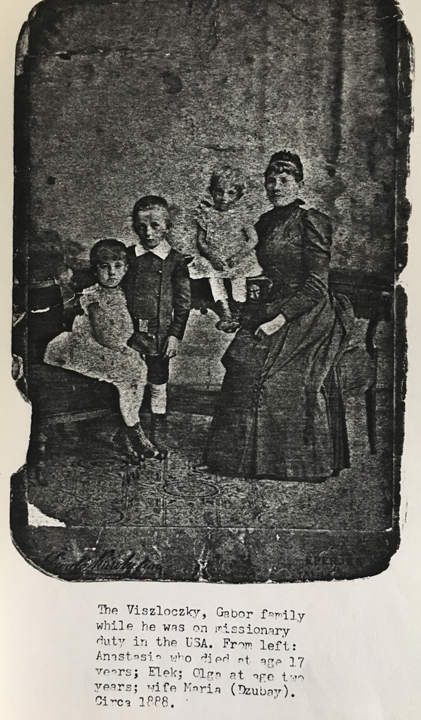
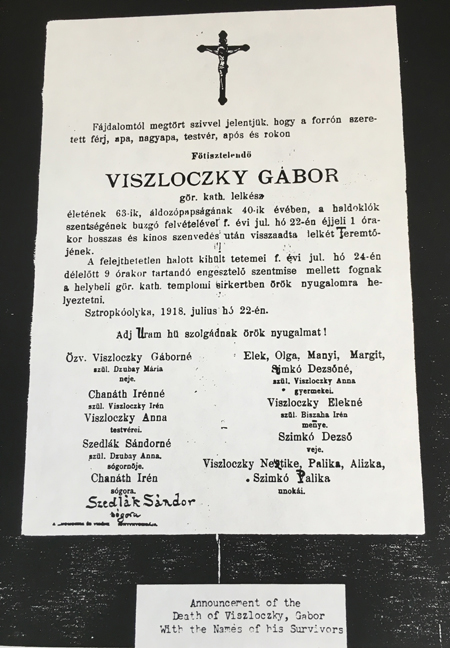
Father Gabor's parents-
Father Anton Viszloczky born about 1823 in Litmanova, Slovakia and wife Pani Victoria Viszloczky nee Kovaliczky born about 1832 in Puzana, Slovakia.
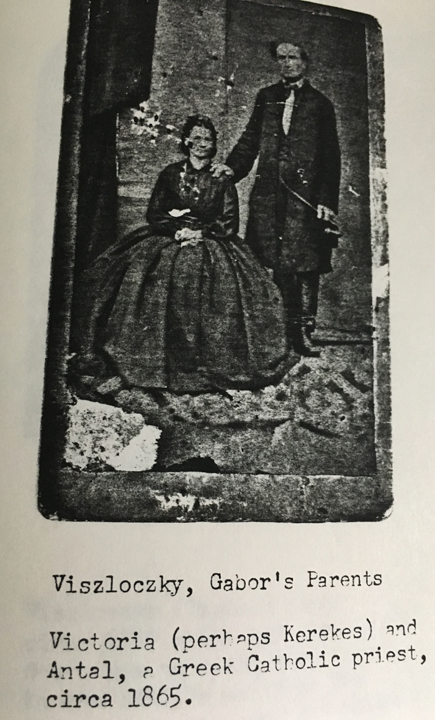
Reverend Father Alexis Vislocky
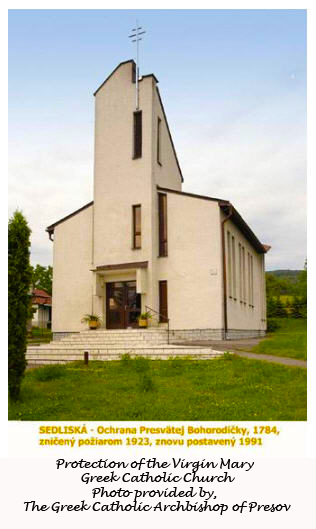
Alexis Gabriel Vislocky was born on April 27, 1885 in Sedliska, Slovakia into a Greek Catholic priestly family. He was the son of Reverend Father Gabriel Vislocky (son of Reverend Father Anton Viszloczky and Victoria Kovaliczky) and Maria Dzubay. Prior to his ordination he married the former Irene Maria Bisaha in 1909. Irene was the daughter of Reverend Father Michael Bisaha and Eugenia Hvozdovics. Father Alexej was ordained a Greek Catholic priest at Saint John’s Greek Catholic Cathedral, Presov, Slovakia on August 28, 1909. He served the Greek Catholic village churches in Zavadka from 1909 to 1916 and Vyrava from 1916 to 1920. In 1920 he immigrated with his family to the United States. He served as resident pastor at St. Mary's Patronage of the Mother of God Greek Catholic Church in New York, New York for 32 years. He later served at St. John the Baptist Greek Catholic Church in Rahway, New Jersey. Father Vislocky authored many publications, articles and language grammars in Rusnak and Hungarian. The Bisaha/Viszloczky Collection of Carpatho-Rusyn Materials is archived with the New York Public Library, Slavic & Baltic Division, 1999. Father Alexis and Pani Irene were the parents of four children, Anastasia (1911-1980); Paul (1912-1993); Alice (1914-1990); and Katherine (1919-2002). Pani Irene died on February 22, 1921 in Manhattan, New York. Their daughter Anastasia (Sister Mary Basil) became a nun and in 1958 pronounced her solemn perpetual vows as a member of the cloistered Poor Clare Nuns in Chicago, Illinois. She served this order for 40 years until her death in 1980. Their daughter Katherine together with her sister Alice founded the choir for Saint Michael's Russian Catholic Church. In the 1930s, Katherine and Alice were members of the Lay Apostolate movement and the Catholic Evidence Guild. Katherine was a graduate of Hunter College, and pursued a career as a research assistant at several University Hospitals. In 1950, she married Dr. Count D. Gibson, Jr. The couple played an active role in the civil rights movement. Later they moved to Palo Alto, CA, where Katherine continued her education at the University of California San Francisco. She earned her Master's of Social Work in 1973. In conjunction with Catholic Charities she founded a foster grandparent program and pursued an avocation as a hand bookbinder. In later life she organized and managed the preservation of the personal collection of books belonging to her father and grandfather and donated them to the New York Public Library. This collection is a priceless resource for those interested in the culture and religion of the Carpatho-Rusyn people.
Greek Catholic Church in Slovakia - Eparchy of Kosice (On-Site)
Greek Catholic Cathedral of the Birth of the Most Holy Mother of God
(Photo Credit - Marian Gladis)
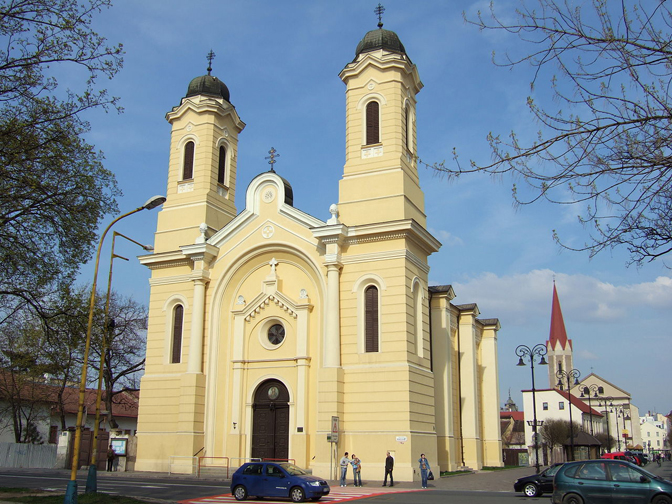
Greek Catholic Cathedral of the Birth of the Most Holy Mother of God in Kosice, 1940s
(Credit Youtube.com Posted by Gréckokatolíci za obnovu východnej tradície)
100 Year Anniversary (1886-1986) of the Greek Catholic Cathedral of the Birth of the Most Holy Mother of God in Kosice
(Credit Youtube.com Posted by Vladimir Timkovic)
This is an archival film from 1986, processed in 2017. At the time of the magnificent celebration, one can see personalities: The Servant of God Father Andrej Timkovič (1919-1987), Father Ján Hirka (1923-2014) - in 1986 Apostolic Administrator of the Archeparchy of Presov, Father Viktor Skorodenský, Father Vojtech Boháč, Father Juraj Bujňák, the theologian Cyril Vasiľ (today's Archbishop) and the interior of today's Greek-Catholic cathedral in Kosice during Christmas, 1986.
Bishop Gregory Tarkovič, (1745-1841)

Vechnaya Pamyat - Eternal Memory

The first Greek Catholic bishop of the Eparchy of Presov was Bishop Gregory Tarkovič. He was born November 21, 1745 in the Ruthenian village of Pászika / Kishidvég, Szolyava District, Bereg County, Austro-Hungary (Pasika, Zakarpats'ka Oblast, Ukraine). His father was a cantor and grandfather, Jan Tarkovič, served for a year in 1788 as pastor of the Greek Catholic Church of Saint Michael the Archangel in Kőrösfő, Saros County, Austro-Hungary (Okružná, Slovakia). Gregory began his religious studies as a young child. He was a very intelligent student and memorized all of the Greek Catholic services. He attended the Jesuit managed Gymnasium in Uzhorod and he decided to enter the Jesuit Order. Gregory Tarkovič was quoted as saying “Upon acceptance into the Jesuit Order, I considered myself the happiest man on earth.” He traveled to Nagy Varad in Hungary to further his education. His intelligence and knowledge of theology were brought to the attention of Bishop Andrew Bachinsky. The bishop, seeing he had great promise, directed he expand his theological studies in Vienna, Austria. Gregory Tarkovič was ordained by Bishop Bachinsky as a Greek Catholic priest on January 1, 1779 at the Church of the Basilian Fathers on Chernecha Hora near Munkács, Austro-Hungary (Mukachevo, Ukraine). During this period, he was appointed professor of the Theological School in Mukachevo. In 1793, he assumed the duties at one of the largest parishes in that region. Because of his intelligence and vast knowledge, he was appointed official censor of Slavic books in Budapest, Hungary during the year 1803. In 1804 he was promoted to Canon of the Mukachevo Diocese. In 1813 he was assigned to administer the Vicariate of Kassa, Abauj-Torna County, Austro-Hungary (Kosice, Slovakia).
It was decided by the Holy See that a bishop was required to head the newly formed Greek Catholic Eparchy in Eperjes, Saros County, Austro-Hungary (Presov, Slovakia). This Eparchy would minister eventually to the needs of the faithful in present day Slovakia, Hungary and Southern Poland. While there were many potential candidates for this position, Bishop Gregory Tarkovič’s name remained the most qualified. Emperor Francis I appointed him the first Bishop of Presov and the Holy See, in conjunction with consent of Pope Pius VII, confirmed his nomination on September 26, 1818. There were many difficulties at first as to housing, financial needs and the establishment of an entire eparchy where one had not existed before. However, all these obstacles could not contain the great happiness of the faithful who at last had their own bishop. During the time it took for construction and renovation of buildings for the new eparchy, Bishop Tarkovič resided in Vienna, Austria. On June 17, 1821 he was consecrated by Bishop Alexis Pocsy of Mukachevo in the Monastery Church at Krásznibrod, Zemplin County, Austro-Hungary (Krasny Brod, Slovakia) and on this day, he was installed officially as the first Bishop of the Greek Catholic Eparchy of Presov.
Bishop Tarkovič saw a great need for education of the faithful. He is remembered as the Bishop who began the idea of each village having a school run by the pastor of the local church. This practice later developed into a combination school for religious studies and secular learning. He also instructed his priests to minister to those in prisons and to seek out those who could not attend church. He also set down the practice where a priest had his main parish but would minster to other areas with no church. His first thought was always for the faithful and he spent countless hours pondering how he could better their lives. On November 18, 1821, the Bishop held the First Eparchial Synod in Presov. The Basilian Fathers who had two monasteries in the Eparchy, Krasny Brod and Bukova Hirka were also represented. Slowly, with the help of the faithful and the clergy, Bishop Tarkovič established the foundations for the Eparchy of Presov and expanded the Greek Catholic faith.
Bishop Tarkovič made a great contribution to the newly founded eparchy, an Eparchial Library. The main contributor was his close friend, John Kovach from Budapest, Hungary. Mr. Kovach established a foundation, obtained many new books and even formed an organization to supply the finances necessary to maintain the library. To honor his dedication to this vital need of the eparchy, Bishop Tarkovič dedicated the library as “The Kovach Eparchial Library.” Others joined in this worthy endeavor and began donations of literature. Some of the donators were Greek and Roman Catholic priests, professors and wealthy patrons. This library was highly valued as the eparchy had no official seminary during this time. Sadly, the entire library was confiscated in 1950 by the communist government.
Bishop Tarkovič was a very spiritual bishop and spent countless hours in prayer. It was said when he was celebrating services he was so humble people called him “Saint Nicholas.” One of the reasons for this is he had a beard, which, he was the last, and only, sitting Greek Catholic Bishop of Presov to wear one. By the year 1830 the custom of growing a beard by the Greek Catholic clergy began to fade out of fashion. Bishop Tarkovič was also devoted to teaching young and old their Greek Catholic faith. He spent countless hours promoting this cause within the eparchy and among the faithful. After his tireless service to the Greek Catholic church, he died on January 14, 1841, he was 96 years old. He was interred in the crypt beneath Saint John’s Greek Catholic Cathedral in Presov where his burial site can been seen to this day.
Bishop Joseph Gaganec, (1793-1875)

Vechnaya Pamyat - Eternal Memory

Joseph Gaganec was born in Vysny Tvarozec, Saros District, present day Bardejov District, Eastern Slovakia on April 10, 1793. His father was employed as a government civil servant and his family resided in various towns during his youth. Joseph studied at schools in Bardejov, Levoca and Nové Mesto nad Váhom, Slovakia. He attended the University of Trnava for this theological studies and graduated with high honors. After graduation, he married Anna Kovalicky, who was the daughter of the Greek Catholic pastor, Andrew Kovalicky, of Kany, Slovakia. On March 8, 1817 he was ordained to the Greek Catholic priesthood by Bishop Samuel Vulcan of the Romanian Greek Catholic Diocese of Oradea Mare, Romania. Father Gaganec served various Greek Catholic Churches in the towns of Ruske Pekl’any, Viszlo and Hejce. Sadly, his beloved wife passed away while he was pastor in Hejce. During his tenure, he worked tirelessly to improve educational opportunities for Greek Catholic children. He began parochial schools and established a well-rounded curriculum for all ages. He was so successful in his efforts that government teachers sought his advice for their schools. His efforts did not go unnoticed and in 1835, Bishop Tarkovich nominated him Canon of the Presov Chapter along with Father Basil Popovich. During 1838, Father Basil Popovich was enthroned as the Bishop of Mukachevo. He offered the name of Father Gaganec to succeed the first Greek Catholic Bishop of Presov, Bishop Tarkovich who had passed away. Bishop Basil Popovich enthroned Father Gaganec as the second Greek Catholic Bishop of Presov at the Imperial Court Chapel in Vienna on June 25, 1843.
Bishop Gaganec now undertook the massive task of firmly establishing the Greek Catholic Eparchy of Presov. In time, due to his outstanding administrative abilities and tireless work, the Greek Catholic Eparchy of Presov would become the best managed of all Greek Catholic eparchies. He immediately looked to improve the Cathedral which was placed directly under the patronage of Saint John the Baptist. In 1846, he installed an iconostasis which is still in the Cathedral to this day. He also constructed a Bishops residence in 1848 and began a monthly stipend to the clergy from a Religious Fund known as “congruna.” He gave strict instructions to the clergy they were to be a good Christian example to everyone, that they be properly dressed, well-groomed and always continue to be educated.
During 1848, he held an Eparchial Synod that address the religious and cultural life of the Greek Catholic faithful of the eparchy. Bishop Gaganec was well aware of the needs of the faithful. His priests were ordered to learn farming and gardening so that they could instruct the faithful to have better lives. During the years 1847 through 1849 many problems affected the eparchy. Outbreaks of famine, cholera and the Hungarian uprising saw a decline in the population of the eparchy. Bishop Gaganec continued to work tirelessly to alleviate the suffering of the faithful. Bishop Gaganec organized various funds to help poor villages, orphans, widows and those in need of further education. He established a school “Alumneum” in Presov to help those who wanted to further their education. He also began plans for a Greek Catholic Seminary but these would be completed by his successor, Bishop Nicholas Toth.
Bishop Joseph Gaganec strived to improve the lives of the faithful. In recognition of his efforts, in 1854, Emperor Franz Jozef I knighted him with the Order of Francis Joseph, a very high distinction for any of the Catholic clergy. In 1868 for his “pastoral merits and apostolic seal” Pope Pius XI made him “Assistant to the Papal Throne and Count of Rome.” Later, another honor was bestowed upon him when Emperor Franz Jozef I appointed him his “Privy Councilor.” It was well known Bishop Joseph Gaganec was devoted to his flock and, he never accepted money or gifts for himself. He followed the words of Jesus Christ who said, “give to all who ask of you.” He lived as a simple priest, always willing to listen to anyone’s trials and never turned anyone away who asked for guidance. The mark left upon the Greek Catholic Eparchy of Presov is felt to this day by all he accomplished. Bishop Joseph Gaganec firmly established the Greek Catholic Eparchy of Presov and it would be left to future bishops to continue building on his well-structured foundation. Bishop Joseph Gaganec passed away on December 22, 1875 in Presov. His Funeral Mass was held in the Cathedral he served in for so many years. He was interred in the Cathedral cemetery in Presov, Slovakia.
Bishop Mikuláš Tóth, PhDr. (1876-1882)
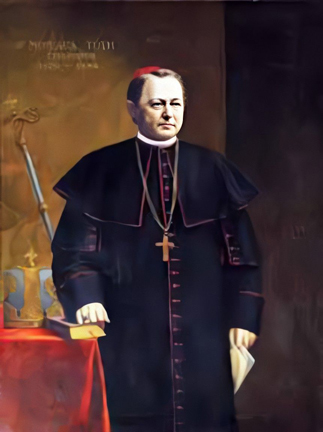
Vechnaya Pamyat - Eternal Memory

Mikulas Toth was born into a Cantor's family of Hungarian background on August 10, 1833 in Mukachevo, Ukraine. After receiving his basic education, he continued his studies at the school in Satu Mare, Romania. It was here that he also completed his studies in philosophy. During this time he felt a calling to the priesthood and began studying theology. Seeing his scholarly aptitude, Bishop Vasil Popovic of Mukachevo, Ukraine sent him to study in Budapest. He was ordained a priest by Bishop Popovic on December 18, 1857 on the Holy Day of Saint Nicholas under the old calendar in Černečka Hora near Mukachevo. Continuing his studies, he received a doctorate in theology in 1860. Afterwards, he became a professor of theology in Uzhhorod, Ukraine. Father Toth was an excellent orator and because of this, he was appointed professor of morality at the University of Budapest. Due to his compassion and deep spiritual credentials, Bishop Pankovič, who appointed him in 1873 as a Mukachevo Canon (a member of the clergy who are responsible for administering a cathedral or a number of churches) was installed as the rector of the Uzhhorod Greek Catholic seminary.
After the death of the Greek Catholic Bishop of Prešov, Bishop Jozef Gaganc, the Holy Father, Pius IX, appointed him to the vacant bishop’s throne in Presov on April 3, 1876. His consecration took place on May 21, 1876 at Holy Cross Cathedral in Uzhhorod, Ukraine. As a former university professor, his first thought was to begin building up church educational buildings. He worked tirelessly and even supported a large number of students from his own funds. He believed no Greek Catholic child, even if they were poor, should go without a good solid education. In addition, he founded several organizations to support young people, orphans and the poor. His crowning achievement was the opening his own Eparchial Greek Catholic Seminary on September 12, 1881. Prior to this, theologians had previously studied in Uzhhorod, Budapest and Esztergom. The seminary was given the same name as the cathedral and to this day, it is called Saint John’s Greek Catholic Seminary in Presov. Bishop Toth worked non-stop and travelled throughout his eparchy to perform canonical visits and see that his eparchy was being run effectively. During 1881, he was instrumental in having the interior of Saint John’s Greek Catholic Cathedral in Presov renovated. Sadly, before he could continue with his service to the church and faithful, he died suddenly at the young age of 49 years old on May 21, 1882. He had only served as the Greek Catholic Bishop of Presov for six years but, he had done so much for the faithful who he loved so much. He was solemnly buried with the participation of both Greek and Roman Catholic Clergy, the faithful and many friends in the crypt of Saint John’s Greek Catholic Cathedral in Prešov, Slovakia.
Bishop Jan Hirka
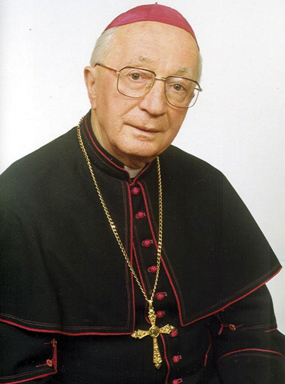 On Thursday, April 10, 2014, in Presov His Excellency, Bishop Jan Hirka (1923-2014) died in his 90th year. He was in the 65th year of his priesthood and 25th year as a Bishop. He was born in Abranovce, Slovakia and ordained a priest in 1949. Reverened Hirka was appointed Apostolic Administrator of the Archeparchy of Presov when it was revived on April 2, 1969, after years of suppression under communist rule. He was appointed Eparch on December 21, 1989 and ordained as a bishop on February 17, 1990. Bishop Hirka retired on December 11, 2002.
On Thursday, April 10, 2014, in Presov His Excellency, Bishop Jan Hirka (1923-2014) died in his 90th year. He was in the 65th year of his priesthood and 25th year as a Bishop. He was born in Abranovce, Slovakia and ordained a priest in 1949. Reverened Hirka was appointed Apostolic Administrator of the Archeparchy of Presov when it was revived on April 2, 1969, after years of suppression under communist rule. He was appointed Eparch on December 21, 1989 and ordained as a bishop on February 17, 1990. Bishop Hirka retired on December 11, 2002.
Vechnaya Pamyat - Eternal Memory

Jan Hirka was born in Abranovce, former Czechoslovakia, present day Slovakia on November 16, 1923. He was the son of Mihal Hirka and Dorota (nee Krajnak) Hirka. He began his elementary education at the Abranovce village school in 1930. He then attended the Greek Catholic Gymnasium from 1936 to 1944 in Presov which prepared him for advanced academic studies. After graduation on May 3, 1944 he entered the Greek Catholic Seminary in Presov. Bishop (Blessed) Paul Gojdich, then the Bishop of Presov, sent Jan Hirka for further studies at Charles University in Prague. After his studies were completed, he was ordained to the Greek Catholic priesthood on July 31, 1949. Due to the impending communist takeover of Czechoslovakia and a ban on further ordinations in a Cathedral, Auxiliary Bishop (Blessed) Vasil Hopko ordained Jan Hirka in the chapel of the Greek Catholic Seminary in Presov.
Father Hirka was assigned to be an auxiliary chaplain in Lutin, however, he was not permitted by the authorities to assume this post. In February of 1950 he returned to Presov and performed the duties of chaplain at the Episcopal offices. With the forced and illegal liquidation of the Greek Catholic Church by the Communist regime, on April 28, 1950 Father Hirkla was under constant surveillance along with all others in the Eparchy offices. This did not deter Father Hirka to stop his priestly ministry. He became employed as a laborer which enabled him to continue as a Greek Catholic priest secretly. On October 22, 1952, the Communist regime arrested Father Hirka and he was imprisoned in Presov for a term of six months. On April 28, 1953 the “People’s” Court” in Presov sentenced him to three years in prison. Father Hirka appealed this unjust verdict but, he was transported to the prison in Llave. On July 4, 1953, he was released under an amnesty but was forbidden to return to Presov or the Kosice regions for a period of five years. It was nearly impossible for him to serve as a priest. On September 19, 1955 he was arrested once again. Along with him were many Greek Catholic priests and nuns who were put into prison for no other reason than being Greek Catholic. These were difficult days for Father Hirka and all those of the faith. His trial was held at the High Court in Prague and lasted nine days. He was sentenced for two and a half years for “Hostility against the Republic”. He was sent to the forced labor camp in Rtyne and worked in the underground coal mines. He continued to serve all who were in need of ministry even though he could have been shot if discovered. On March 20, 1958 he was released after serving his full sentence. Again, he could not return home as his sentence carried a five year ban on residence in the Presov or Kosice regions. Needing to find employment, he travelled to numerous firms but they would not hire him. Finally, with the help of individuals who were secretly Greek Catholic, he was offered a job in a hospital in Podbrezovska.
Father Hirka worked as a laborer, fireman and as an assistant in the operating room. He then requested an opportunity to be trained as an electrician which, the hospital was in need of. After his training he repaired electrical appliances at the hospital and in medical offices. This training had a dual function for Father Hirka. It provided him with a job but also, permitted him to travel and, once again, secretly attend to the needs of Greek Catholics. After his probation was lifted, he returned to Presov and worked in a hospital as a handyman until 1968. At this time, the Greek Catholic Church was partially restored and he was permitted to become a parish priest in Presov as the district dean. On December 20, 1968 His Holiness, Pope Paul VI appointed Father Hirka Apostolic Administrator of the Greek Catholic Diocese of Presov. This appointment required the approval of the Communist authorities which was not granted until April 2, 1969. However, the communists refused to permit the seat of the bishop of Presov to be filled. Father Hirka had a great weight on his shoulders. He was responsible for the entire Greek Catholic Church in Presov and the surrounding regions. He was not permitted to reside or utilize the Cathedral offices. He stayed in a two room apartment with his parents and then resided at a parish office in Presov. Due to his faithfulness and hard work under such terrible conditions, on March 21, 1978, His Holiness, Pope Paul VI granted him the title of Honorary Prelate and Monsignor. In 1988, Saint (Pope) John Paul II decided to come to Slovakia and dedicate the Lutin Basilica. The Communist authorities did not like this decision but there was nothing they could do. Thousands of people, Catholics and non-Catholics alike, attended this dedication. The authorities tried to stop the dedication by turning off power and water to the site but the dedication continued. In November of 1989 the “Velvet Revolution” was taking place. The Communist regime finally was cast off and on December 21, 1989, Saint John Paul II appointed Monsignor Jan Hirka residential Bishop of Presov. His consecration was performed by Cardinal Jozef Tomko on February 17, 1990 in Presov. Bishop Jan Hirka was the first Greek Catholic bishop legally enthroned since the communist regime liquidated the Greek Catholic Church in 1950.
While this was a positive aspect for the Greek Catholic church, it brought Bishop Jan Hirka many difficulties. The church had been dismantled, service books destroyed, seminaries closed. Bishop Hirka now had to rebuild the church which had been silenced for so long in Slovakia. Bishop Hirka stated to work non-stop to rebuild churches, expand services that had been forbidden and obtain necessary books and items so churches could function. Bishop Hirka opened the Greek Catholic Seminary to meet the needs of the growing numbers of applicants who, under the Communist regime could not identify themselves as Greek Catholic. Bishop Hirka began a diocesan charity to assist elderly Greek Catholic members who were in dire need. He also revitalized church traditional music and co-founded the Greek Catholic Festival Choir which eventually obtained European notoriety. On July 2, 1995 Saint John Paul II visited Slovakia once more and recognized the suffering and loyalty of Greek Catholics during the persecution of their church. Bishop Hirka also was present at the beatification of Blessed Bishop-Martyr Paul Gojdich who Bishop Hirka knew personally. Bishop Hirka continued to re-build the Greek Catholic church in Slovakia and received numerous awards from the government and various educational institutions. Bishop Hirka also believed it was important to remember the past and he worked to assemble materials of Greek Catholic Church life for the previous 35 years.
In 2002, Bishop Jan Hirka retired and a new Bishop who later would become the current Archbishop-Metropolitan of the Greek Catholic Church in Slovakia, Jan Babjak, succeeded him. Bishop Hirka continued working as a priest after retirement. He served as a Greek Catholic priest and a Bishop of the Greek Catholic Church for a total of 65 devoted years. After receiving the last rites of the church Bishop Hirka died on Thursday, April 10, 2014. In his testament, he requested to be interred with his parents in his native village of Abranovce. The main celebrant at his funeral was Metropolitan Jan Babjak and other Greek and Roman Catholic priests and bishops. His devotion and service to the Greek Catholic Church will not be forgotten.
Photos provided by, The Greek Catholic Archbishop of Presov
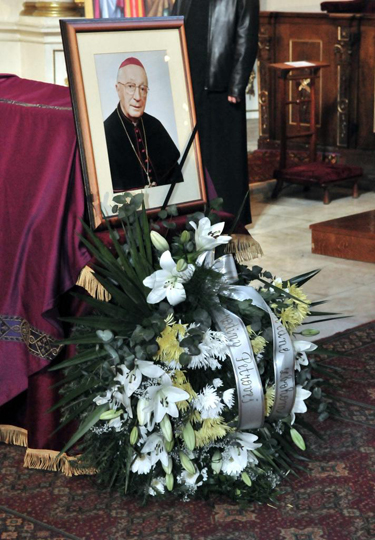
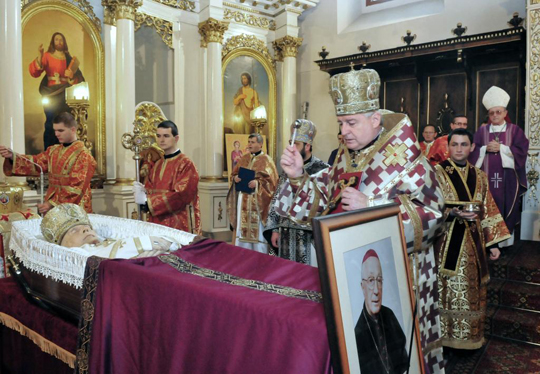
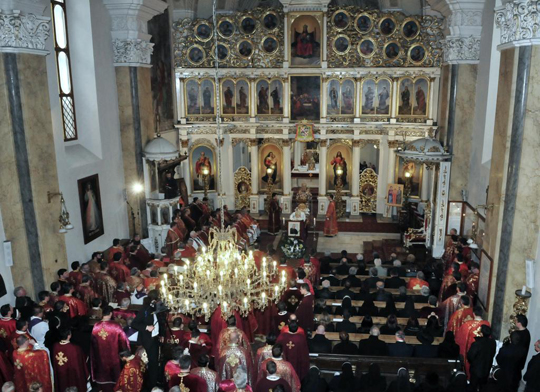
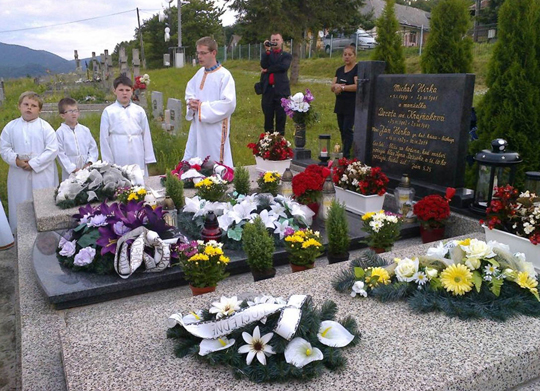
Father Cyril Fedeles, (1881-1950)
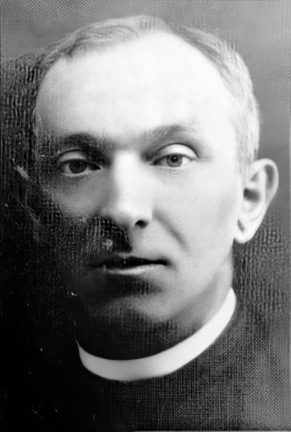
Cyril Fedeles was born on August 20, 1881 in Topol’a, Zemplin District, present day Slovakia. His father was John Fedeles, parish priest of Saint Michael the Archangel Greek Catholic Church in the village and his mother was Gizella Bachinsky. The village of Topol’a at this time had a wooden Greek Catholic Church constructed in 1700. Cyril would assist his father with services and in tending to the needs of the faithful. He received his primary education at the village school. Later, he was sent to Uzhorod, Ukraine to complete his secondary education. He attended the Greek Catholic Eparchial Seminary in Uzhorod for philosophical and theological studies and graduated in 1906. Showing great scholarly promise, he was assigned the instructor of religion for Greek Catholic children in Budapest, Hungary. It was at this time he began to consider the priesthood and follow in his father’s footsteps. His older brother Vladimir (died 1986 and interred at Mt. St. Macrina Cemetery, Uniontown, Pennsylvania) also became a Greek Catholic priest and would eventually immigrate to the United States and serve within the Greek (Byzantine) Catholic Archeparhy of Pittsburgh, Pennsylvania. During 1908, he married Margaret Panzer and immediately afterwards was ordained by Bishop Julius Firczak, Greek Catholic bishop of Mukachevo, Ukraine. He was assigned to serve in Greek Catholic parishes but World War I ended with a massive shortage of teachers.
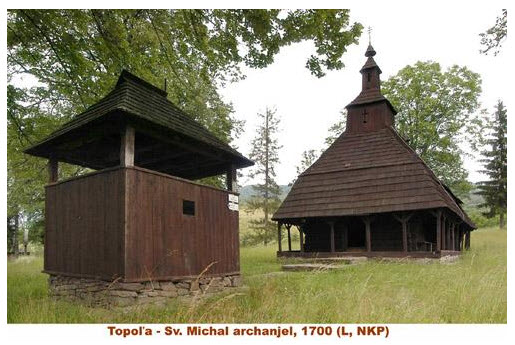
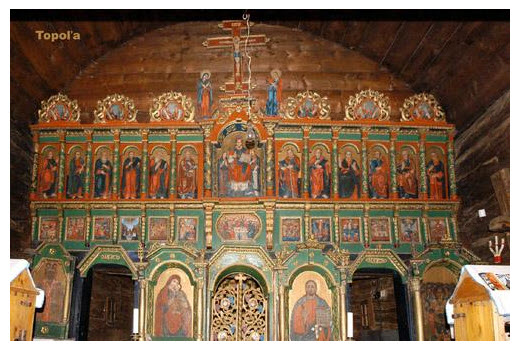
Photos Provided by, The Greek Catholic Archbishop of Presov
Due to his education and gentle nature, he was assigned as professor of Ruthenian and Latin languages at the Gymnasium in Uzhorod, Ukraine. While there, he also studied and successfully earned a Master’s Degree in Education in 1928. Father Cyril enjoyed teaching and in his spare time would also conduct catechism classes for young children. Due to the need for educators, he was once again transferred to the Gymnasium in Berehovo, Ukraine as a professor of German and religion. During his time there he began the “Ruthenian National Home” which served as a place for learning and cultural events. In 1939, he was arrested while participating in a protest and was detained in Varju Lapos. Bishop Alexander Stojka of Mukachevo complained about Father Cyril’s detention and he was released soon afterwards. Father Cyril was then assigned by the bishop to serve the Greek Catholic church and faithful in Lipcha, Ukraine. Father Cyril spent a few years here which he thoroughly enjoyed. The good sized town had close to 3,000 residents during his tenure. Located in a valley, the town was surrounded by a large river with mountains in the distance. Residents were a mixture of Ruthenians, Hungarians, a small community of Jewish families, Romanians and some Germans. A large percentage of the town were Greek Catholic and Father Cyril worked tirelessly on their behalf especially during the hard times of World War II.
In 1946, the communist regime assumed power and no one could have imagined what terror awaited them. This region experienced some of the most intense oppression and Father Cyril was arrested for “anti-communist writings.” The communist government wanted to suppress all forms of religion and they pressured Father Cyril to recant his Greek Catholic faith. They did everything to make him renounce Catholicism and sign a “confession” but, he would not do it. The communists lost patience with him and had a show trial. Father Cyril was sentenced to seven years of hard labor in a prison camp. As he was a very popular and well-loved priest and academic, the government moved him from on prison to another constantly. It was their thought after time, no one would remember him. Sadly, this is what would happen and the details of his imprisonment and death would not be revealed until long after he passed away. The guards pushed Father Cyril so hard it is a miracle he survived as long as he did. After working to the point of exhaustion in the day, they gave him the “easy” job of night watchman at the camp near Dniprodzerzhinsk, central Ukraine. He was forced to stay up all night and if he nodded off, would be kicked and beaten. He suffered terribly during winter along with all the other prisoners as they had no winter clothing or boots. In secret, he offered what spiritual comfort he could and blessed those who died from starvation, neglect and disease.
It is impossible to comprehend what Father Cyril and his fellow prisoners endured. After being starved and worked without rest, he just collapsed. The guards left him and he was found, frozen to death, on March 27, 1950. To this day, no one really is sure where he was buried or if he was. Many times the prison camps would just discard those who passed away into a pit or, leave them in wooden areas for animals to carry off. The one thing that can be said is he was a martyr, persecuted only for being a Greek Catholic and it is with this faith he took his last breath.



